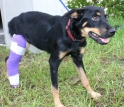News Release 05-142
Four-legged Family Members Must Be Included in Emergency Plans
Concern for pets is main reason why some won't evacuate disaster areas

Okaloosa (Fla.) animal services director comforts a woman seeking a temporary home for her dog.
August 16, 2005
This material is available primarily for archival purposes. Telephone numbers or other contact information may be out of date; please see current contact information at media contacts.
Editor's note: September 2007 has been designated as National Preparedness Month to raise awareness about the importance of emergency preparedness and to encourage all Americans to better prepare their homes and communities for emergencies.
Over the past several decades, household pets have come to occupy an increasingly intimate place in the modern family, gaining nearly the status of children or other loved ones. Yet, according to University of Colorado, Boulder sociologist, Leslie Irvine, caring for pet safety in a disaster has often been an afterthought.
"Almost 100 percent of people who have pets describe them as family members," said Irvine. "And all family members need to be considered in a disaster plan."
In a presentation last week at the annual meeting of the Society for Social Problems in Philadelphia, Irvine said pets and livestock are now on the radar screen when emergency teams respond to a hurricane, chemical spill or other catastrophe.
Nearly a decade ago, that was not the case. Evacuations from Hurricane Andrew left some 1,000 deserted pets to be euthanized for lack of space to care for them. In 1999, more than 3 million pets and farm animals died in the wake of Hurricane Floyd.
Irvine contrasted the loss of animals during those disasters with data she collected in Fla. last year in the aftermath of Hurricane Charley, which was rated a category 4 storm with winds up to 145 miles per hour.
She examined interagency communication, the role of volunteers, animal identification procedures, interagency communication, and how emergency workers provided assistance to anguished pet owners who were separated from their animals.
Her main finding: "No animal had to be euthanized due to lack of space."
Irvine also studied how human attitudes, which she calls "myths," influence emergency workers and their approach to free-roaming animals in a disaster area.
"Alongside the myths about looting and price gouging, hurricane Charley revealed the myth of what I call 'the dangerous dog pack,'" she said. Although scientific studies have not confirmed that behavior in newly displaced house pets, it "has serious implications for the treatment of animals displaced by disasters," Irvine said.
Animals may suffer when such myths pervade "Incident Command Systems"--firmly institutionalized and successful sets of procedures for managing people in a crisis. Irvine called for a re-examination and modification of emergency response plans to better reflect actual, personal experiences with animal behavior.
-NSF-
-
A young volunteer comforts a kitten after Hurricane Ivan.
Credit and Larger Version -
A lost dog with a broken leg received treatment at a temporary animal shelter.
Credit and Larger Version -
A Bay Area Disaster Animal Response Team (DART) member cares for two orphaned racoons.
Credit and Larger Version -
When left alone during a disaster, animals must care for each other.
Credit and Larger Version -
The Code 3 Response Vehicle takes the role of an emergency veterinary hospital.
Credit and Larger Version
Additional information is available in the University of Colorado press release: http://www.colorado.edu/news/
Information on disaster preparedness for pets, horses and livestock is available through:
The Humane Society of the United States: http://www.hsus.org/hsus_field/hsus_disaster_center
The American Veterinary Medical Association: http://www.avma.org/disaster/saving_family.asp.
Media Contacts
Joshua A. Chamot, NSF, (703) 292-7730, email: jchamot@nsf.gov
Peter Caughey, University of Colorado at Boulder, (303) 492-4007, email: caughey@spot.colorado.edu
Program Contacts
Dennis Wenger, NSF, (703) 292-7014, email: dwenger@nsf.gov
Principal Investigators
Leslie Irvine, University of Colorado at Boulder, (303) 492-7039, email: ileslie1001@qwest.net
Related Websites
NSF Award Abstract: http://www.nsf.gov/awardsearch/showAward.do?AwardNumber=0080977
The U.S. National Science Foundation propels the nation forward by advancing fundamental research in all fields of science and engineering. NSF supports research and people by providing facilities, instruments and funding to support their ingenuity and sustain the U.S. as a global leader in research and innovation. With a fiscal year 2023 budget of $9.5 billion, NSF funds reach all 50 states through grants to nearly 2,000 colleges, universities and institutions. Each year, NSF receives more than 40,000 competitive proposals and makes about 11,000 new awards. Those awards include support for cooperative research with industry, Arctic and Antarctic research and operations, and U.S. participation in international scientific efforts.
Connect with us online
NSF website: nsf.gov
NSF News: nsf.gov/news
For News Media: nsf.gov/news/newsroom
Statistics: nsf.gov/statistics/
Awards database: nsf.gov/awardsearch/
Follow us on social
Twitter: twitter.com/NSF
Facebook: facebook.com/US.NSF
Instagram: instagram.com/nsfgov





